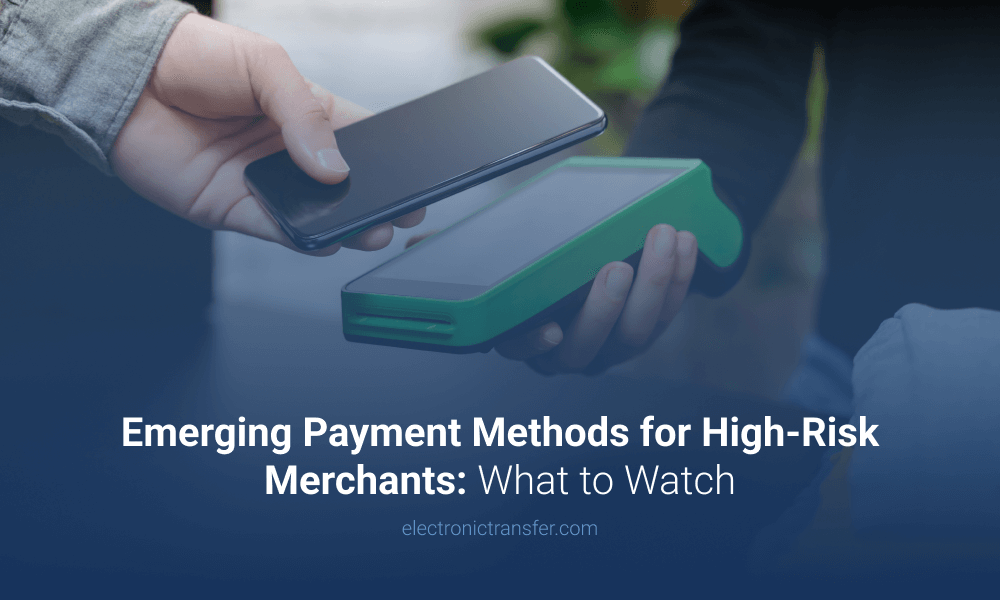Emerging Payment Methods for High-Risk Merchants: What to Watch

Historically, high-risk businesses have relied on conventional payment methods such as credit card processing, ACH payments, and wire transfers. While these remain wildly important, they often come with higher fees, longer processing times, and stricter regulations.
This has led to a growing demand for alternatives. Fortunately, as technology evolves, new payment options are emerging that offer more flexibility.
Emerging Payment Methods for High-Risk Merchants
Mobile Wallets and Contactless Payments
The rise of smartphones has led to the widespread adoption of mobile wallets like Apple Pay, Google Pay, and Samsung Pay. These services use Near Field Communication (NFC) technology to enable contactless payments.
For high-risk businesses, mobile wallets offer:
- Enhanced security: These services use tokenization to protect sensitive data.
- Convenience for customers: Many consumers prefer the ease of mobile payments.
- Integration with loyalty programs: Some mobile wallets allow for seamless rewards tracking.
The main challenge though is ensuring that their point-of-sale systems are compatible with various mobile wallet platforms.
Crypto Payments
Cryptocurrencies like Bitcoin and Ethereum have gained traction among high-risk businesses. They offer several advantages:
- Payments can be processed quickly, often within minutes.
- Transaction costs are typically lower than traditional methods.
- Cryptocurrencies can provide a good level of anonymity for customers.
- They enable easy cross-border transactions.
However, cryptocurrencies also have their drawbacks. Their value can be volatile, and regulatory uncertainty remains a concern in many jurisdictions. Additionally, businesses must be prepared to handle the technical aspects of accepting and managing crypto payments such as integrating crypto payment gateways.
Blockchain-based Payment Solutions
Blockchain solutions promise increased transparency and reduced fraud. However, they’re still in the early stages of development and adoption.
Blockchain technology, which underlies cryptocurrencies, has been creating new opportunities such as:
- Smart contracts: These self-executing contracts can automate payments based on predefined conditions.
- Decentralized finance (DeFi) applications: These systems offer financial services without traditional intermediaries.
- Stablecoins: These cryptocurrencies are designed to maintain a stable value, addressing the volatility concerns of other digital currencies.
Electronic Checks and ACH Innovations
E-checks and ACH (Automated Clearing House) payments are not new, but recent innovations have made them more attractive to high-risk businesses:
- Same-day ACH: This allows for faster processing of electronic payments.
- Account validation technologies: They reduce the risk of fraud as well as issues due to insufficient funds.
- Improved security measures: Enhanced encryption and fraud detection tools protect against unauthorized transactions.
Alternative Payment Methods
Alternative financing options help high-risk businesses access capital and manage cash flow. For example:
- Merchant cash advances: Businesses receive a lump sum in exchange for a portion of future sales.
- Revenue-based financing: Repayments are tied to monthly revenue, offering flexibility during slow periods.
- Peer-to-peer lending platforms: These connect businesses directly with investors, where more favorable terms than traditional banks are often offered.
The above options can be particularly useful to high-risk businesses that struggle to secure traditional bank loans. However, they may come with higher costs and should be carefully evaluated.
Security Measures for Emerging Payment Methods
New purchasing methods often bring about new safety concerns. To address these, businesses have to be ready to invest in strong protective measures. These include:
- Advanced fraud detection systems that use machine learning to spot suspicious transactions.
- Data protection methods that include encryption and tokenization to safeguard sensitive information.
- Multi-factor authentication strengthens user authentication by requiring multiple forms of identification.
Choosing the Right Payment Method
It is clear that a business cannot implement every payment method at once and needs to introduce them gradually, considering the type of business and its specific needs.
When evaluating new payment options, consider:
- Cost: Compare fees, including setup costs, transaction fees, and chargeback rates.
- Speed: How quickly can you access those funds?
- Customer preferences: Which payment methods do your target customers prefer?
- Integration: How easily can the new method be incorporated into your existing systems?
- Risk management: Assess the potential for fraud or chargebacks with each method.
Compliance and Regulatory Considerations
Staying compliant with the regulations is crucial to avoid legal issues and maintain banking relationships. This includes:
- Know Your Customer (KYC) and Anti-Money Laundering (AML) requirements: These regulations aim to prevent financial crimes and apply to most payment methods.
- Data protection and privacy laws: Businesses must ensure they handle customer data in compliance with regulations like GDPR and CCPA.
- Industry-specific regulations: Certain high-risk industries may face additional rules governing payment processing.
Three Future Trends in High-Risk Payment Processing to Keep In Mind
Looking ahead, several trends will most likely shape the future of payments for high-risk businesses:
- Artificial Intelligence and Machine Learning: These technologies will play a growing role in risk assessment and fraud prevention.
- Biometric authentication: Methods like fingerprint or facial recognition are becoming more common forms of payment authorization.
- Central Bank Digital Currencies (CBDCs): Government-backed digital currencies could offer a stable, regulated alternative to private cryptocurrencies.
Wrap Up
While traditional methods still have their place, emerging technologies offer new opportunities for faster, more secure, and flexible payments. By carefully evaluating these options and staying abreast of regulatory requirements, high-risk companies can find solutions that meet their unique needs and support their growth.
Electronic Transfer Inc. has decades of experience offering payment processing solutions to high-risk businesses. Our expertise spans both traditional as well as emerging and future payment technologies, ensuring that we can successfully guide your business through the evolving financial landscape.
For personalized advice on optimizing your payment strategy, contact ETI’s experts today. Let us help you navigate the complexities of high-risk payment processing and position your business for future lasting success!


